Alfred Dunhill's fascination for the tubular pipe
Auteur:
Don Duco
Original Title:
Alfred Dunhill's fascinatie voor de tubular pipe
Année de publication:
2007
Éditeur:
Pijpenkabinet Foundation
Description :
A prehistoric tubular smoking pipe from the collection of Alfred Dunhill discussed in comparison to four other tubular pipes from different continents originating from early English pipe collections.
Those who have an interest in the origin of smoking are immediately faced with the question how the oldest pipe would have looked like. The prototype of the pipe with a bowl for burning the tobacco and a separate stem to inhale the smoke, is in fact a rather advanced instrument and not the oldest type of pipe. In many cultures the tubular pipe or in short tubular was used and archaeological specimen prove that the tubular is the archetype of the smoking pipe. The most primitive type of pipe would therefore also be the oldest, although this is not true in every culture.
An author who paid much attention to the tubular is Alfred Dunhill. In his renown standard work The Pipe Book, an entire chapter is dedicated to this type of pipe. In fact his book starts with this chapter on the origin of smoking, where he specifies the early dating of the tubular. He also claims, partly on the authority of other writers, that the first smokers snorted smoke through a straw or bone tube, or rolled tobacco leaves into a cigar. Both resulting in a cylindrical or tapered form, which developed into the tubular. Gradually, a durable material like ceramic was chosen and hence the tubular pipe was born.
In this article I will describe the oldest pipe from the private collection of Alfred Dunhill in London. A pipe with a special meaning for Dunhill, because for him it reflected the prototype of the smoking pipe. After a brief discussion, I will compare this pipe with four other tubular pipes originating from four other continents. These pipes are also discussed in The Pipe Book. Two copies are not from Alfred Dunhill’s own collection, but they were known to and even studied by him. It is quite remarkable that all five objects are now included in the collection of the Pijpenkabinet in Amsterdam. Similarities and differences in material, form, technique and decoration of the five specimen are interpreted, including the way of smoking and the place that these pipes played in their respective society.
North America
As mentioned before, the earliest and the oldest tubular pipe in the Dunhill collection is a prehistoric specimen from an excavation in California, the region where the native Indians have introduced the tubular pipe as an utensil in common use. It is a tube identical to the specimen shown in Dunhill's pipe book (Fig. 1). In the first edition of 1924 Dunhill himself did not yet own an example of this type of Indian pipe. For that reason, he illustrated a sample from the British Museum. The specimen discussed here must have been added to his collection after1924.As was his intention, this pipe originates from the same culture and has similar physical characteristics as the British Museum item.
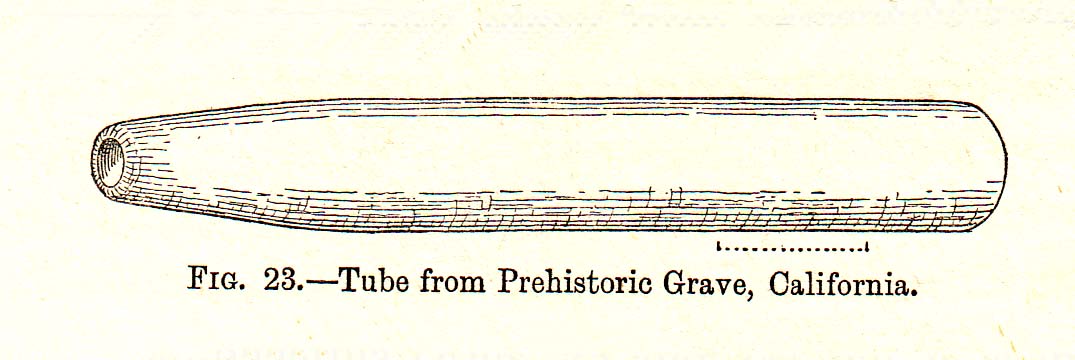
It is a monumental object in brownish-black steatite with a slight tinge of green (Fig. 2). The length of the pipe is just over fifteen centimetres. The object as a whole is slightly conical, but narrows at both ends, so that a light oval shape is created. Around the bowl opening one sees a discreet thin incision , while the stem end is tapering and rounded off. Around the stem end the edge is slightly uneven and less tight than desirable. The pipe is perfectly preserved showing some wear of long use. Although rare, pipes like these are excavated more often in prehistoric graves in California. This specimen was found just over the Mexican border near (La Misión de) San Miguel, a town in the north of the peninsula, south of California, parallel to the coast of Mexico. The finder is said to be a man named S. Bowers, but the pipe came indirectly through the circuit of collectors and researchers in Dunhill's collection. Thanks to an inscription in white ink central on the pipe the information about the source came to us.
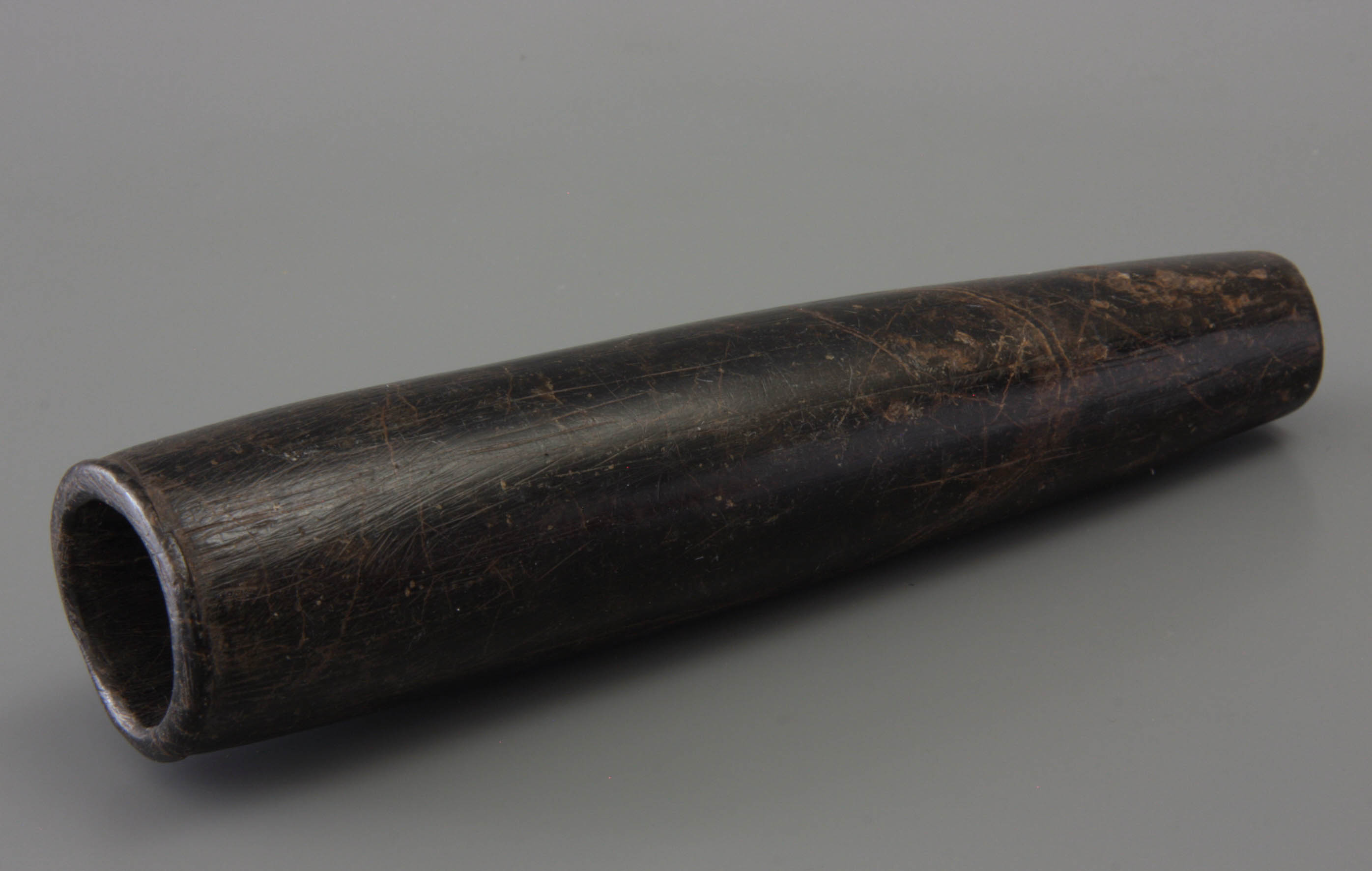

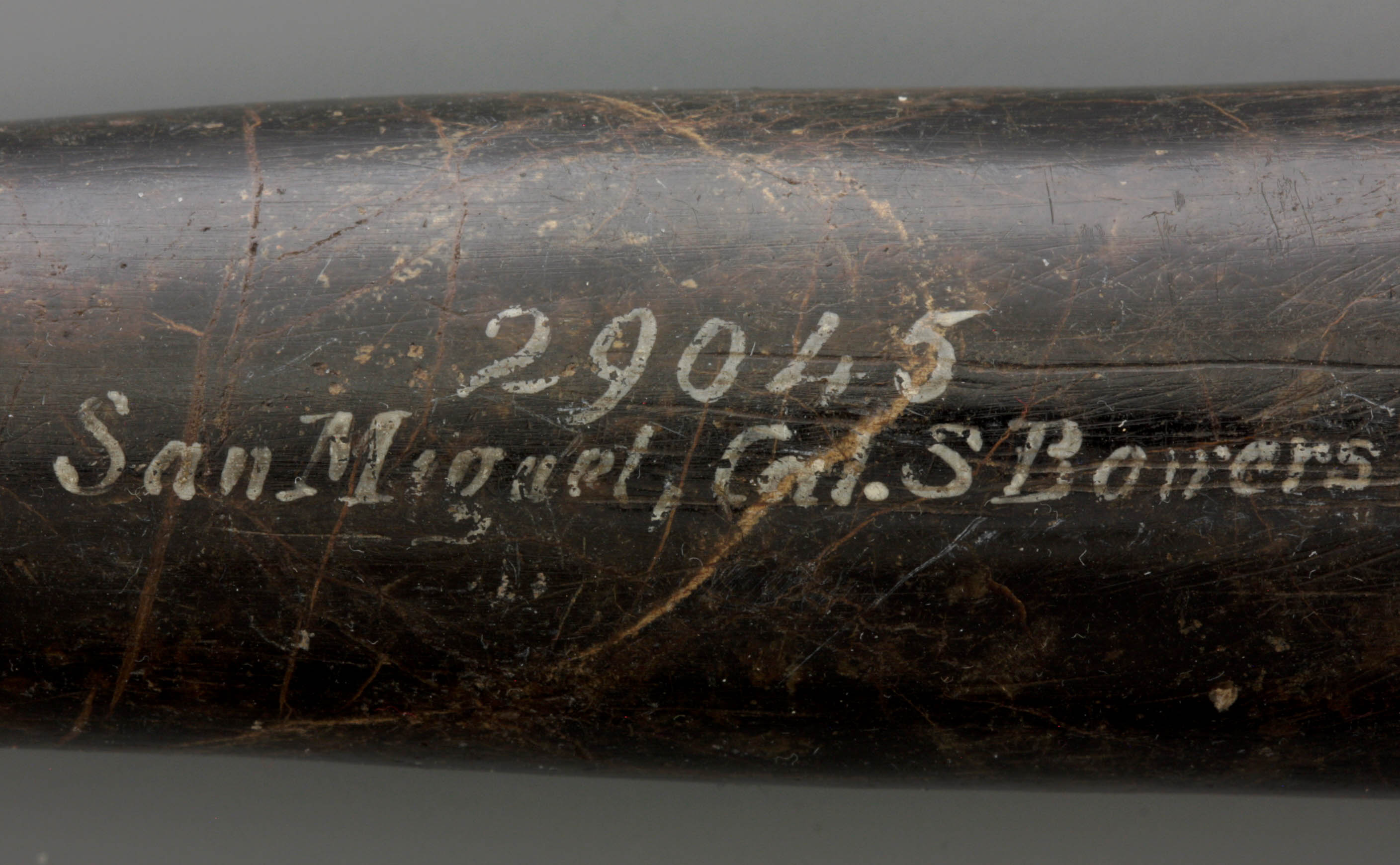
At first sight the tubular form seems to be made on a primitive lathe, certainly the most logical and efficient way to do. However, the Indians still worked completely out of hand in this early period. The object was hollowed out by using a flint as drill attached to a stick. The stem is drilled from one side of the pipe with a rather thin drill, the bowl is made from the other side with a larger flint drill. By manually rotating the shaft of the drill the interior is not purely cylindrical but shows rings with a light gradient. The exterior is shaped out of the hand including the ring round the bowl opening. In short, it is a completely hand-made object.
After drilling, the pipe was finished in detail. Internally, the bowl section was further sanded and polished to get rid of the rings of the drilling in order to make the bowl better functional. The outside surface was polished, but numerous scratches and grinding marks still testify the use of primitive tools . We may assume that a new pipe always showed a web of such grinding traces. In the course of using these scratches became worn giving the object a smooth shiny surface, eventually with an attractive patina of frequent use.
Internally, half of the tube length is intended to be filled with tobacco. The actual pipe bowl has a diameter of 2.4 centimetres and a depth of about 7 centimetres. The distinction between bowl and stem is not visible on the outside of the pipe. In assessing the shape of the object, we must be aware that this stone tube is only half of the pipe. How unexpected it might seem, the American Indians fitted this item on a hollow stem or on a piece of bird bone (note 1). The tubular was thus smoked with a separate stem. The connection between the two parts was made airtight by using bitumen (note 2). This is still visible in the stem part, where, despite its age, traces of some kind of glue are present.
Filling the pipe is something special. First, a small plug of grass is put at the bottom of the bowl, in order to prevent tobacco crumb entering the stem and eventually coming in the mouth of the smoker. The tobacco smoked by the Indians in this region, is not cut in slices but is crushed till almost a powder form, hence the grass filter is a necessity. The tobacco is tightly pressed and then lit with a piece of coal. If the pipe burns well the tobacco can be covered with a small stone to maintain the right tension in the pipe, but also to prevent the scattering of ashes and tobacco crumbs. The powdered tobacco and the stone lid make it more or less necessary to smoke the pipe in a vertical position. Of course, this affects the smoke posture of the user who will have laid down while smoking.
It is not easy to date this object. In many American Indian cultures the tubular pipe remained in use until shortly after the year 1900, which means that the period of use of this type of pipe is extremely long: from 500 BC to the turn of the last century. Since the finding or excavating of this pipe, probably between 1880 and 1920 the details about the origin got lost, as often happens with collectibles. For certain is that this item is not one of the earliest examples but rather a mainstream product that is more or less standardized. A safe, but still vague dating lies between 500 and 1500 AD.
In short, the pictured pipe is primitive in design and finish, but beautiful in its simplicity. The pipe was used for smoking that was already fairly developed and tested for centuries. Although in this area steatite is the most common stone to find, sometimes serpentine and even sandstone were used. The shape variation of the tubular pipe differs from conical to cylindrical, sometimes with a widening stem end. In rare cases, the transition between bowl and stem somewhere in the middle is indicated by an incision, that gives the pipe a slight resemblance with an hourglass.
There are multiple reasons for the fact that the tubular pipe stayed unchanged at the American Indians for over 25 centuries. The step from a tubular shape to a pipe with a stem and a distinguishable bowl at an angle is a huge one. The drilling of two holes from different direction and even more the connection between these two pipe parts was difficult to realize. In addition, smoking a tubular pipe was an established habit among the Indians. Smoking was automatically associated with a particular lying position hence the corresponding traditional pipe. This ingrained pattern did not ask for a change.
South America
There is quite some similarity in pipes from North and South America. The main difference is that the North American objects are studied extensivelyso that a lot of information is available. Far less is known about the culture of pipe smoking in South America. Despite the lack of information Alfred Dunhill cites in his publication pipes typical for Paraguay in a tubular shape (Fig. 3), one of which is shown here. Such pipes are named Paraquaays or Chaco pipes after the region of origin. Dunhill reports that the archaic pipes of the North American Indians were copied (note 3).
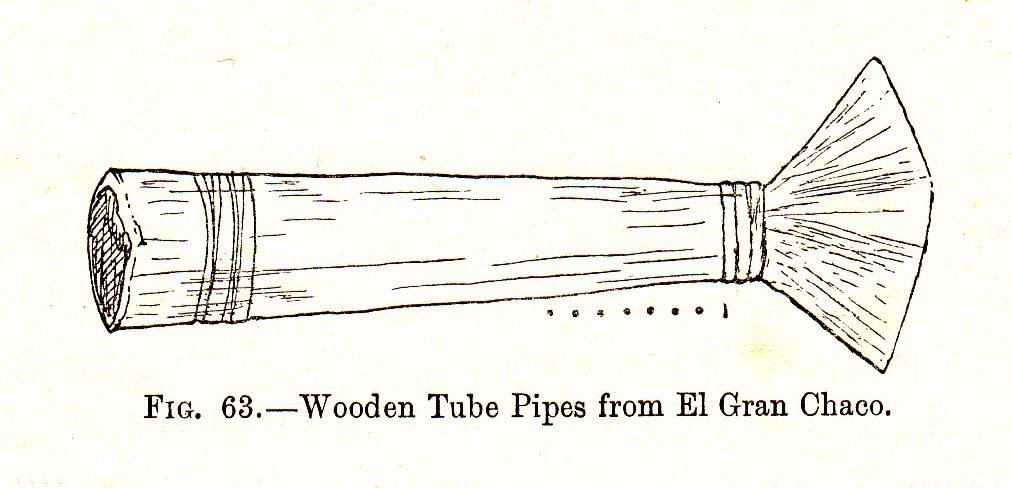
This second item from the Dunhill collection is a simple pipe with a tubular shape, in this case made out of a soft light brown wood (Fig. 4). The pipe is ten centimetres long and of a general type in Paraguay. The shape is extremely well balanced: the bowl section is perfectly straight, slightly tapered and closes at both ends with a small thickened flat band. A flattened triangle, something like a fish tail, acts as a mouthpiece at the thinnest end of the tube. The mouthpiece itself has no ridge or edge to hold it comfortably between the teeth. This object was handheld when placed between the lips.
On the two rings along the bowl part and along the edges of the triangular mouthpiece, an incised zigzag pattern was applied as a decoration using a hot metal instrument. The brown lines make an attractive contrast against the light coloured wood. The decorative pattern on one side of the mouthpiece does not match. It deviates from the other three resulting in a square indent.

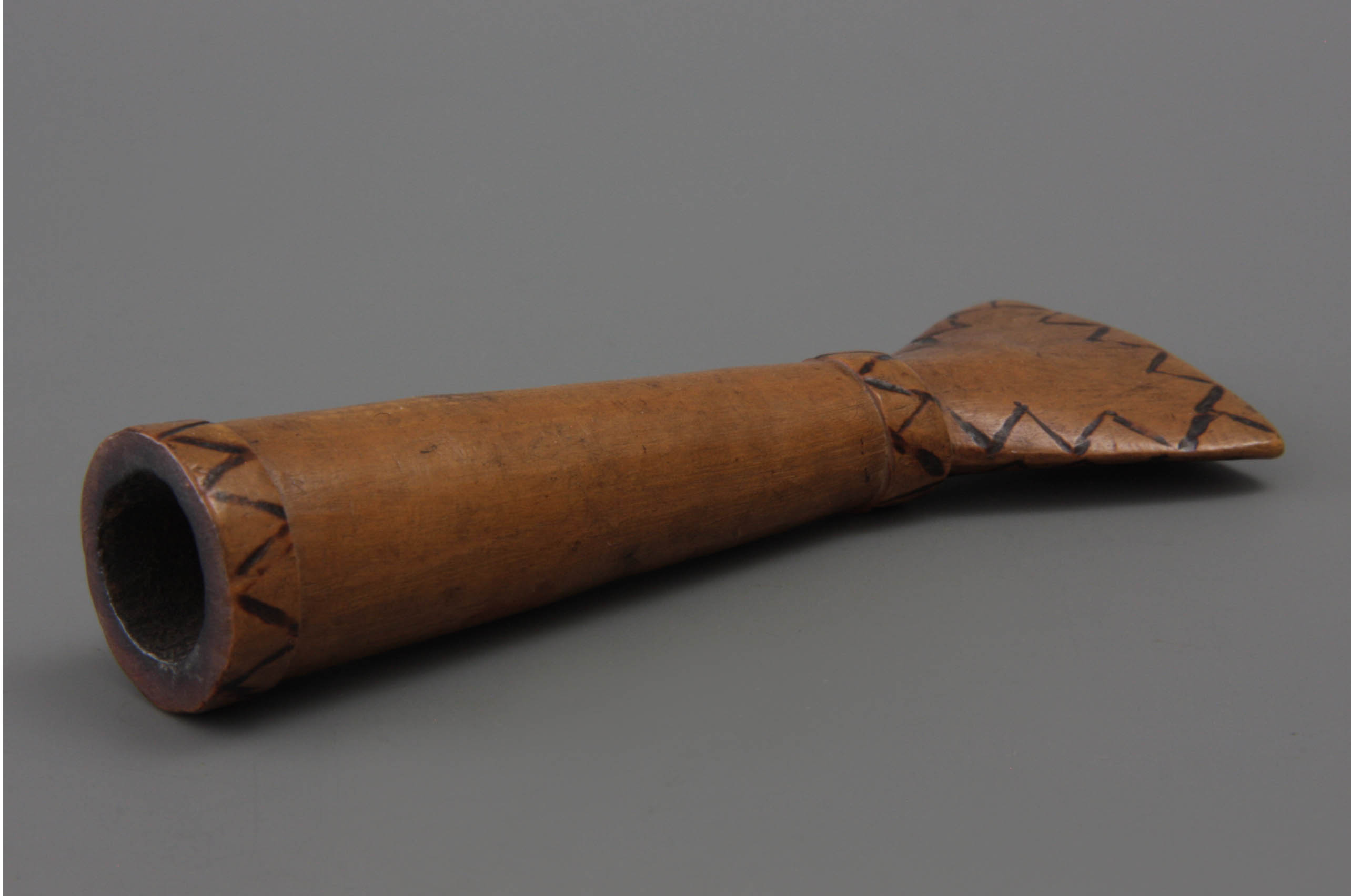
The internal pipe bowl is not as deep as the full tubular form but only goes up to one third. The conical bowl gives the impression that this is not a pipe to be filled with cut tobacco, but rather as a holder for rolled tobacco leaves. In other words this tubular is more a cigar holder than a tobacco pipe. In that respect it differs from the California stone pipe. The method of filling means that a soft wood could be used. Traces of fire on the inside prove that the heat on the wood has been limited, it discoloured the pipe but this did not affect it. In fact, a proper carbon lining has been created. The art of smoking these pipes is more the rolling of the leaf tobacco, in such way that there will not be false air, even though most of the tobacco roll stays outside the pipe while smoking.
Smoking from such tubular pipes has a long history. Although unknown when this type of pipe was introduced, the use continues the entire nineteenth century and even early twentieth century. Wood is the most commonly used material, the typical design having a conical or oval bowl part and a triangular mouthpiece, more or less flattened. Many pipes have a marking in the form of an incised or embossed ring between the bowl and the mouthpiece. These wooden pipes have a variety of finishes, polished specimens exists with simple cut rings. Rarely the object is provided with a decoration, such as the burned pattern of the illustrated pipe. For the smoked pipes the patina of use dominates over its original finish.
These type of tubular pipes are not exclusively found in Paraguay. Among the Mataco Indians of Argentina, this pipe is also used (note 4), while other specimens are known from the Chiquitos Indians in eastern Bolivia (note 5). This shows that the South American tubular is widespread and has been characterized by its own typical design of the triangular mouthpiece. It is therefore not surprising that several museum collections possess such pipes. At the beginning of the twentieth century, this specific tubular pipe disappears, ruled out by the rolled cigarette.
It remains unclear why Dunhill stated that these pipes were copied from the North American tubular pipes. Two facts plea against it. The triangular shaped mouthpiece creates such a separation into two distinctive parts, that you can question whether this is still a tubular pipe. In addition, smoking a roll of leave tobacco as a cigar is fully different from the powdered tobacco of the North American Indians. In the latter case the tobacco burns completely inside the bowl, while at the other the burning takes place outside the pipe.
Africa
As an African example of a tubular pipe an object is chosen from the western part of South Africa (Fig. 5). In this region many pipes were made in serpentine stone, a kind of stone similar to the American steatite but slightly softer and therefore easier to be shaped with a knife. Serpentine stone is characterized by a beautiful lining and a soft colour in different grades from greenish to yellow and brown, always having a warm feeling. The pipe shown here (Fig. 6) originates from the former collection of the tobacco firm W.D. & H.O. Wills from Bristol. This collection of tobacco pipes from all parts of the world goes back to the nineteenth century. In fact, this collection was comparable to the Dunhill collection, besides the fact that it was not published. We know that in compiling his book, Alfred Dunhill also studied this important collection.
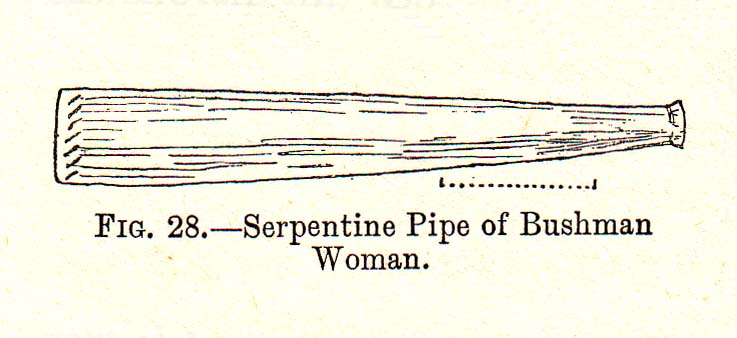
With nine centimetres in length the illustrated pipe is the smallest of the five specimens in this article. The tubular shape seems to be strongly tapered and ends in a small knob. Thanks to this button the pipe can be held between the teeth. These stone pipes were used by the Khoikhoi of the Western Cape, a tribe formerly known as Hottentots. Their pipes are characterized by a delicate shape and attractive finish with a beautifully polished surface. The latter is not the case in this simple example. The surface is unpolished and clearly shows traces of cutting with a knife, recognizable by a pattern of lines that run over the pipe. Otherwise the pipe is made with great care: the wide edge is adorned with a series of oblique lines in between two incised rims. It is a typical decoration that can also be seen on other pipes of this tribe.
The Khoikhoi are known for their highly developed pipes in special shapes. It is said that the serpentine stone was imported from St. Helena, although it is unclear where it was processed. In any case, clay pipes from Gouda and wooden pipes from Ulm were taken as example. The pipe maker made a subtle change to its form that gave the pipe an extraordinary perfection. Because the ability to make such beautiful shapes it is unexpected that at the same time such primitive tubular pipes were produced. This can be explained, however, from the African custom that the status of the smoker is expressed in the pipe. The choice for the tubular shape of the pipe does not indicate underdevelopment, but only has to do with a specific target group. Its use is purely focused on status distinctions: such tubulars were smoked by women only. Men put the women in their subordinate position by letting them smoke these shapeless, unattractive pipes.
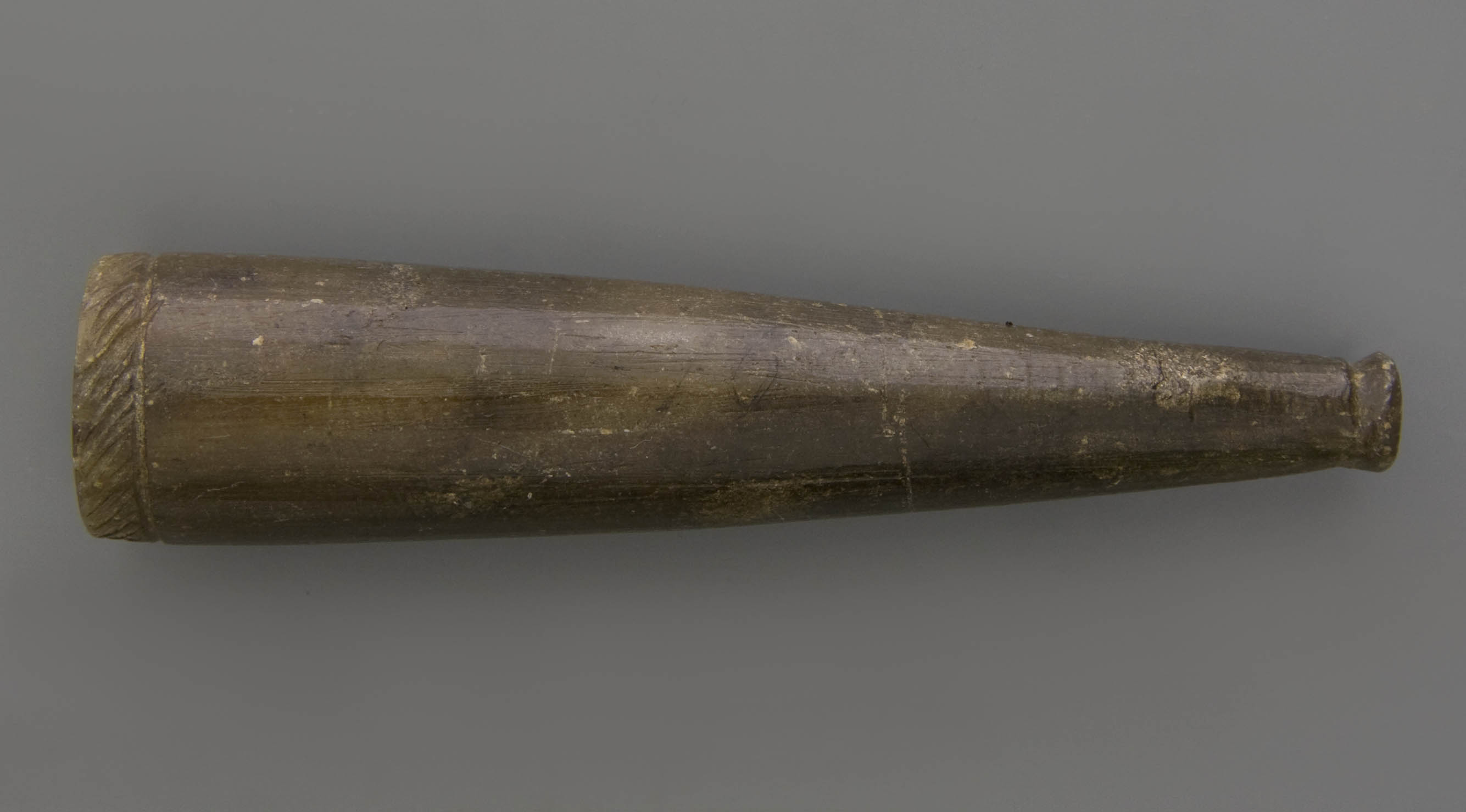

The simplicity of the pipe is not only demonstrated by its shape but also in other features. The beautiful colours of the serpentine stone ranging in different pastels and often with nice colour shades is totally absent in this bleak product. It is probably a deliberate choice to use this undefined deathly dark brown serpentine stone. Also in the finishing without any polishing, we note the poverty of the product. That this pipe still has a decoration around the bowl opening should be explained by the serial production of this kind of stone pipes. Such decoration was done in all instances, although we notice that the work is done with very little inspiration. Would the geometric patterns be missing however, the object would have lost its last charm.
In contrast to the other steatite pipes with a separate stem in wood or reed, this tubular shaped pipe was provided with a knob as mouthpiece, to be held between the teeth. No doubt, the lack of a separate stem underlines the low status of this product. It is unknown what sort of tobacco was smoked in these pipes. For sure this must have been cut tobacco with some stringy cut. Only such tobacco stayed in the pipe during smoking, even then with the chance of spreading crumbs and ashes.
Asia
A beautiful tubular pipe originates from Afghanistan and has completely different characteristics. This kind of pipe is also shown by Dunhill although he gives very little information (Fig. 7). Only the assumption that they may have been made on special request, without further explanation. Multiple examples of such pipes are known in an ever-changing design, but always testifying to the same principles of an established tradition. In any case, Alfred Dunhill must have seen several specimen, including this copy from the before mentioned Wills collection in Bristol.
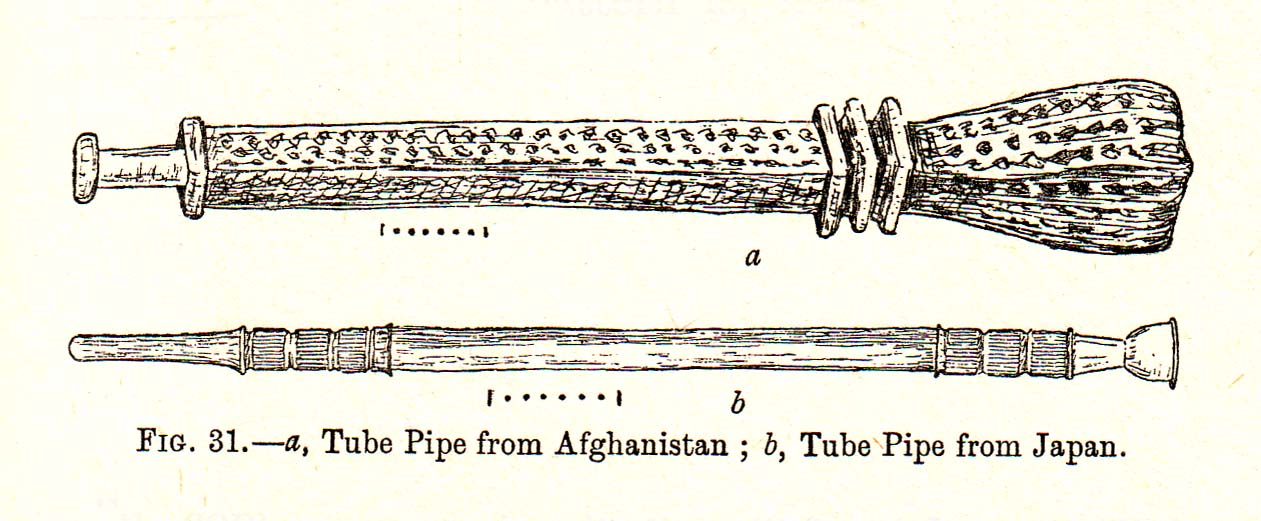
A striking feature of this tubular pipe is its great length of thirty centimetres, and the unexpected quadrilateral shape (Fig. 8). In addition, the pipe displays a particular rhythm of successive geometric shapes, both in bowl and in stem. In contrast to tubular pipes from other cultures, this example shows a clear separation between the bowl part and the stem, clearly readable on the outside of the pipe. The caesura between the two parts is marked by two quadrilateral disks. This provides a wonderful articulation between the square diameter of the stem and the bowl. In fact, this evident dichotomy strengthens the rhythm of the form components. Because the stem and the bowl are clearly distinguishable, the question arises whether this is a true tubular or not. The item could also be defined as a conventional smoking pipe with a 180 degrees angle between bowl and stem.
As noted this pipe design is based on a four-sided cross-section. The stem portion is slightly tapered, and to articulate its relatively great length two undecorated bands were added. Its simplicity of the stem contrasts to the heavier bowl, four sided as well, decorated with longitudinal incisions at the end. An additional decoration is in the local style: a pattern of swallow holes is scattered over the four sides. Such patterns occur not only in wood but also in ceramics and stone objects from Afghanistan. The dotted pattern is the most regular on the bowl, towards the middle of the pipe some added lines create a more vivid pattern.
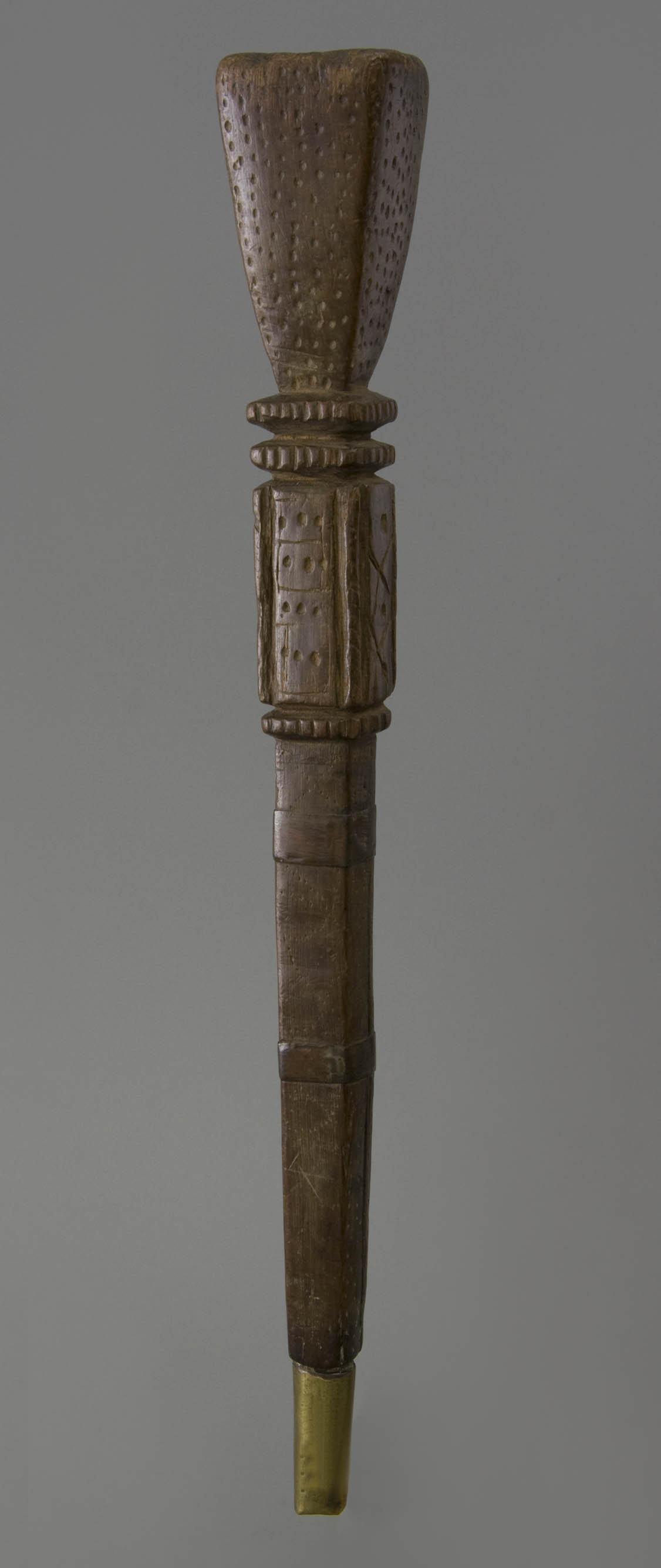

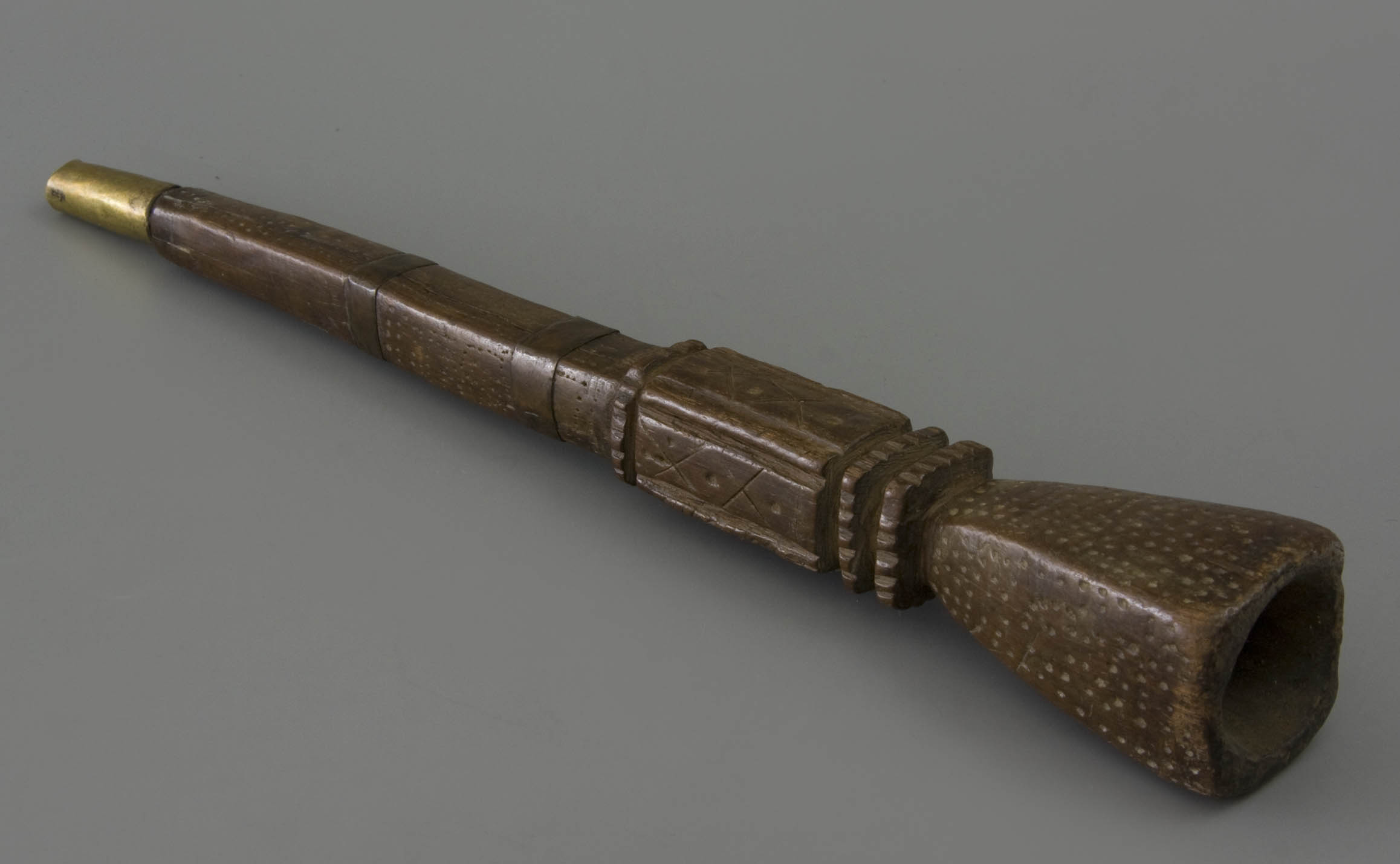
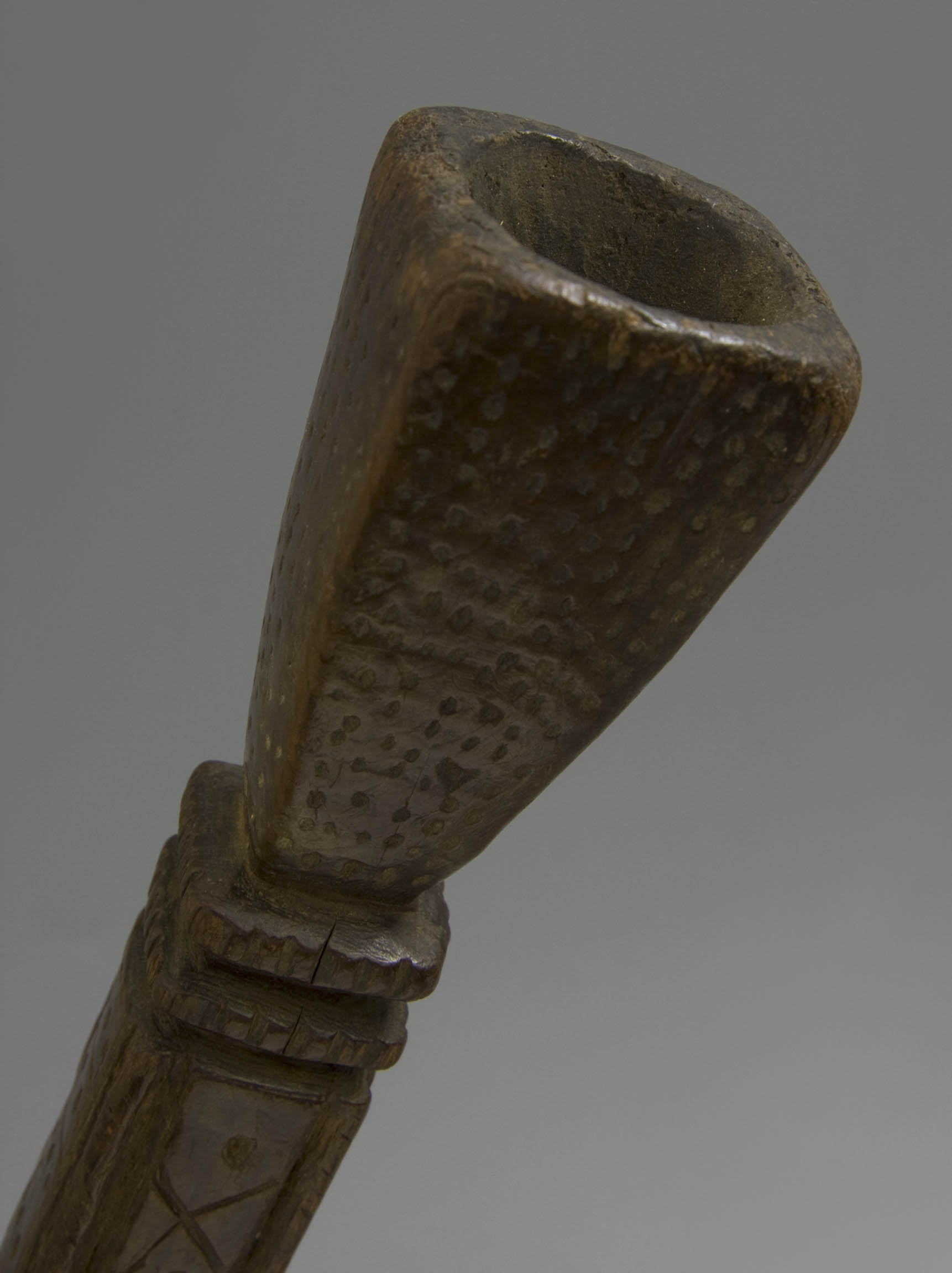
It is interesting that the shape of the bowl has a clear resemblance to the bowls of the hookah pipe from the same area, who are often characterized by conical quadrilation. Even the inside of the pipe bowl is swallow and wide, just like the water pipe bowls. The bowl interior is not protected, for example with sheet metal or any other material. While in use the smoker trusted on a gradual carbon formation, so that the wood of the pipe would not start burning. The soft nature of the wood was reason to strengthen the mouthpiece with a brass band.
In summary the material, shape and decoration of this tubular fits in a smoking culture where the hookah dominates. In this simple pipe the desired cooling of the smoke is achieved by the relatively long stem, which obviously does not give the same comfort as the water pipe. This tubular pipe is more likely a travel pipe, while at home the hookah waited. Pipes in this area are usually filled with a disk-shaped cake of tobacco mixed with a limited amount of hash. The fire temperature is slightly higher than with tobacco pipes, while the smoke is also hotter and stronger. Therefore a longer stem is ideal. In view of the shape of the bowl, the pipe was smoked vertically, hence the smoker used a lying posture.
Europe
In the European cultures, the tubular pipe or tubular was also used, albeit as an exception. The Dunhill collection hardly shows examples, while in his cited The Pipe Book Alfred Dunhill shows only one image. That's when he mentions the so-called onion, a tubular pipe made with a nod to the history of the earliest tobacco pipes (Fig. 9). It is a typical early twentieth century specimen turned out of briar wood and equipped with a separate mouthpiece of buffalo horn. Miraculously Dunhill notes that the product in question is a pipe made by his own firm (note 6).
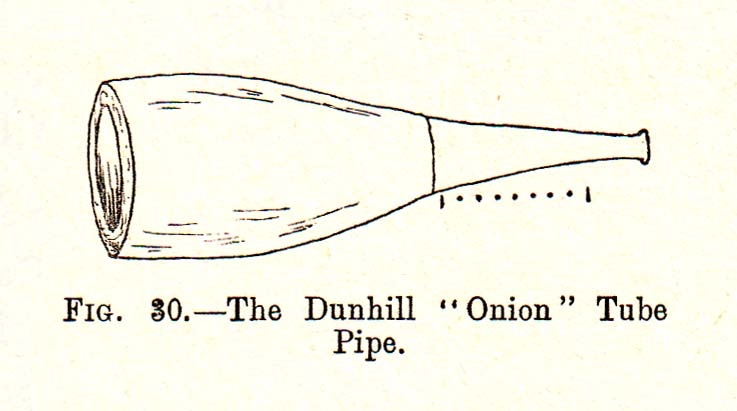
The Onion shown here (Fig. 10) comes from Dunhill's private collection and was the model for the drawing in his handbook. This pipe definitively does not origin from his factory. The fabric has no English character and the quality is below standard. While the earliest Dunhill pipes were made in commission by other factories, already from the very beginning there was a prerequisite for optimal quality. Material, design and finish of Dunhill pipes show a clear English perfection, which lacks in this pipe. The method of turning the briar and the bone tap and buffalo horn mouthpiece put on French origin. However, this concerns a product from the first quarter of the twentieth century.
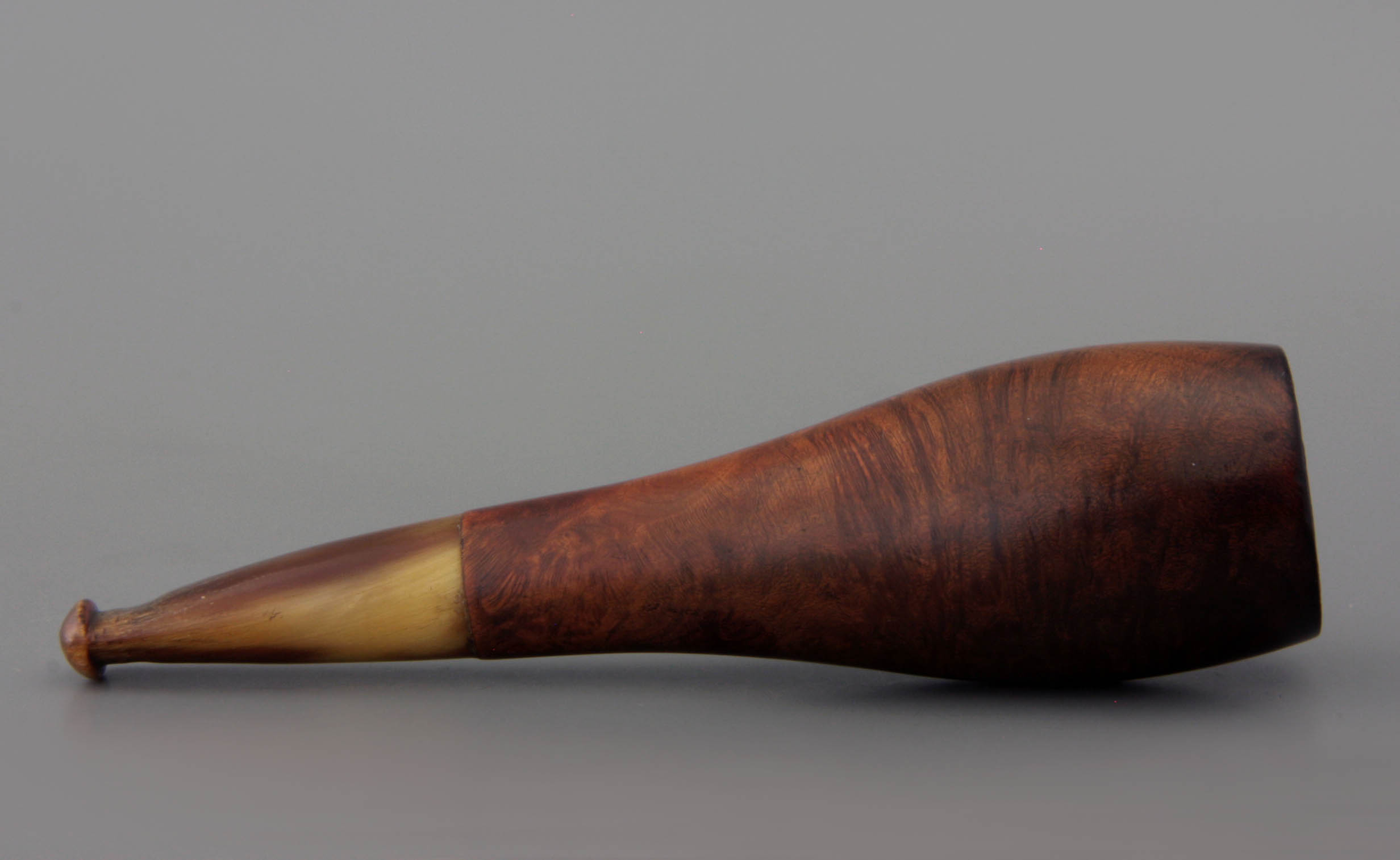
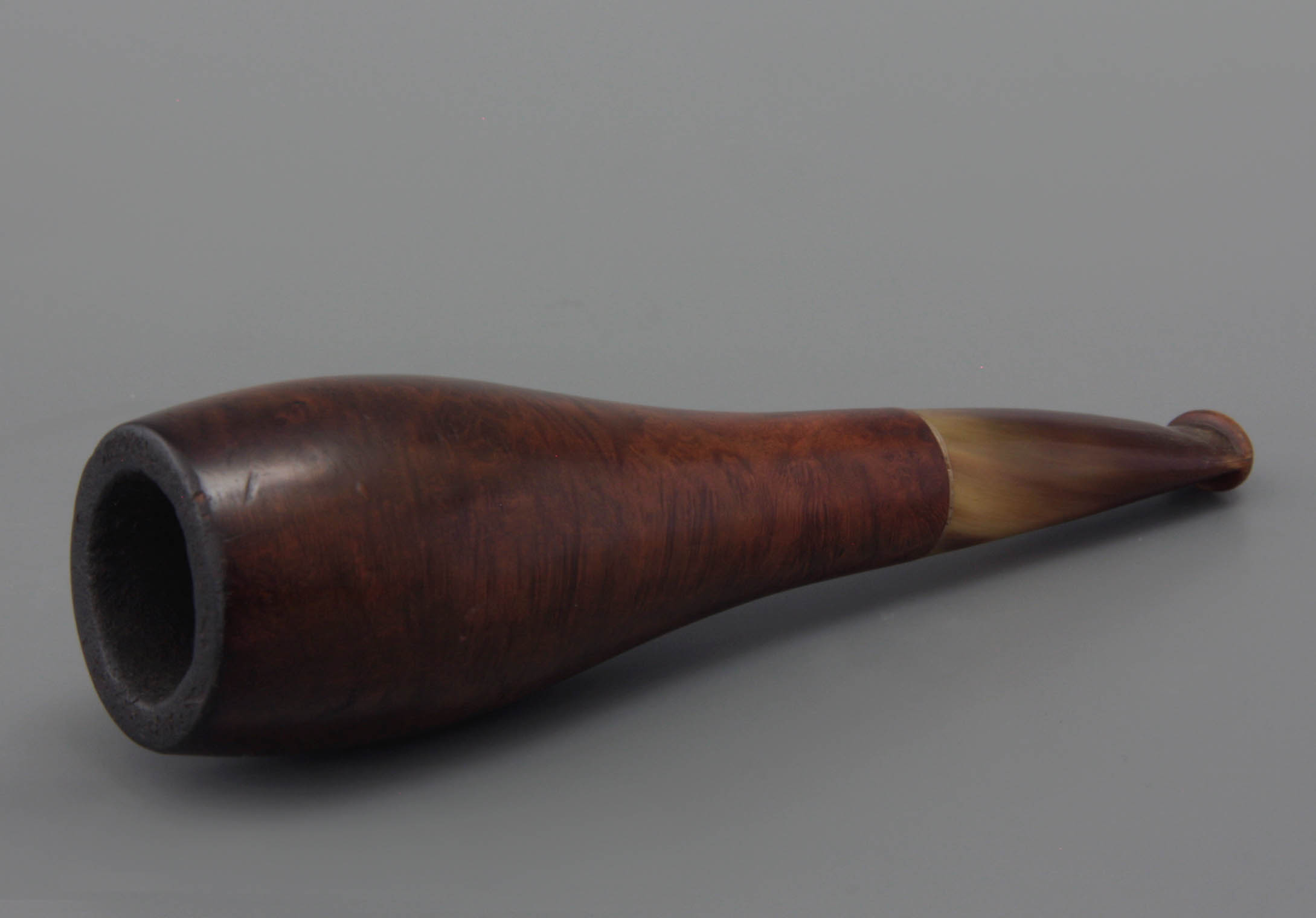
Despite numerous questions about this pipe one fact is for sure: the smoking takes place as with an ordinary pipe. The pipe is filled with the traditional cut tobacco and smoked in the normal way. The attraction of this object is that when smoked it gives the user the silhouette of a cigar smoker. As with all tubulars tobacco crumb and ashes can easily fall out of the pipe, even when tediously filled and carefully smoked. Only in later times manufacturers design a lid to prevent this inconvenience. In this pipe no marks of such a lid are visible. Apparently, the user of this pipe was not disturbed by ashes and tobacco falling out of the bowl, since this product is heavily used. A mystery remains who smoked this pipe, was it Alfred Dunhill himself?
About the modern tubular pipe Dunhill writes in his book that this shape of pipe is still produced by contemporary pipe makers, as he so nicely says to suit individual needs or caprices (note 7 ). Perhaps this profile applies to Dunhill himself, otherwise it is unclear why this pipe remained present in his private collection while the genuine Dunhill onion, that certainly exists, was not represented.
Afterword
Alfred Dunhill's fascination for the tubular pipe is understandable and not without reason Dunhill devotes a chapter in his famous and acclaimed The Pipe Book to this primitive kind of pipes. The tubular is an intriguing smoking pipe with a totally unexpected silhouette and a unique method of use. According to Dunhill the tubular pipe is the archetype of the smoking pipe. Therefore Dunhill starts his chapter by stating that there is little difference between rolling tobacco in a corn leaf or in a sheet of birch bark and putting tobacco in a tubular pipe. No doubt that the use of a tubular pipe fits in human nature and has been an important step in the civilization of smoking. Obviously we can strife about the importance of that step. The difference between the use of ready available materials which burn away in the act, and the making of an object with the purpose to be used again and again marks the step towards a material culture of human beings.
It seems that smoking from a tubular pipe shape was born initially from a need. The choice for this shape is determined by the initial underdevelopment of the ability or creativity to design a smoking pipe with a stem and an upright bowl. Of course, that is not only an idea of the design, but also a matter of technique. The realization of a pipe with a separate bowl, and a separate stem is not a simple task. That only happens centuries after the introduction of the tubular smoking pipe.
The five tubular pipes discussed here are made of stone and wood. Stone is the most obvious, wood as a material is combustible and is therefore in fact not very suitable for a smoking pipe. However, it is generally applied and with success. In addition to the two materials discussed, there are also tubular pipes made of other materials (note 8). There are pipes of pottery known from the Zacatecas from Mexico who are as old as the earliest stone pipes (note 9). Other materials like cane, bamboo and birch bark must have been used in prehistoric times but they did not survive. In later times, new materials such as a tubular pipe entirely in iron from the Sahara region and cast brass pipes from India became available. From Europe numerous examples of tubular pipes are known, made of pipe clay, glass and silver, in later days followed by meerschaum. Most European models are to be regarded as a cigar holder.
In the shape of the tubular pipe more variation is possible than it first seems. The Californian tubular form is the oldest and most primitive: the shape is still almost inarticulate. The most complicated tubular form distinguishes a bowl and a mouthpiece as individual parts and the area between the two parts can be simple, but can also grow to an individual ornament. Both of these parts may have an own form, such is the case in the pipe from Paraguay. The Afghan wooden pipe discussed here gives even more to see: in the complex outline we see three distinct sections. In some cases, it is merely the power of a simple form: the onion is such an example were the two different materials put their own accent.
The appearance of the tubular pipe can also be affected with a decoration. Decorations can enrich the object and give the form a better look or more expression. The smooth band around the opening of the California pipes and subtly decorated bowl opening of the Khoikhoi pipe are the most modest examples. The decorations can also be overwhelming like the rings and dots on the Afghan pipe. Next to the decorations also the texture of the material plays a role, resulting in an attractive interaction between hue, brightness and patterns.
In the way of use of the tubular pipe we see equally remarkable differences. In the tubular form of San Miguel pulverized tobacco was smoked, the onion was chosen for a lengthy cut pipe tobacco which can really be filled stiff. The Chaco Indians learned to fill their pipes with leaves rotated in a modest cigar shape to be clamped in the pipe. They must have understood the art of keeping their butt in the pipe and simultaneously prevent back drafting. The Afghani impose a sticky tobacco cake pressed into the bowl, which is relatively stable, although the use of the pipe in a more or less vertical position is necessary.
It is clear that the filling of the tubular pipe commands also a certain smoke position, and that this again is different for each culture. In the Indian tribes a lying posture when smoking was permitted and even contributes to the ceremonial value of pipe smoking. The same applies to the Afghans, for whom the tobacco with pot had larger influence on their mood. Leaning back or lying to smoke is in those cases granted. However the women of the Khoikhoi did not change their position when they smoked. Their discreet pipes between their teeth, could easily be kept without showing any status, which was exactly the intention of these pipes. The European tubular pipe changes much on the silhouette of the smoker, but hardly to his smoke position. Western men are supposed to walk upright and certainly not lying down or leaning back to smoke. Therefore, the tubular pipe in Europe became a fashion phenomenon mainly for cigar smokers, most interesting but never really popular.
Beyond the culture of American Indians, the tubular pipe had a subordinate role, it remained the alternative to the existing pipe model. Nevertheless, tubular pipes were created in numerous cultures around the world, wherein the size of the bowl and the diameter of the stem had a strong relationship with the method of smoking. For Africa, we see Touareg examples in the Sahara region with a metal pipe (note 10). In India, the bhielpipe also called chillum is another development. In the Netherlands a fashionable pipe for tobacco smoking was invented in the nineteenth century, called polka (note 11). Presumably this pipe is inspired by the emerging fashion of cigar smoking and the purpose of this design was purely focused on the fashion aspect. In all these pipes the material, design, availability of tobacco and smoking custom had a determining influence on the appearance of the pipe.
Regarding the dating of tubular pipes: these span the entire period during which people smoked, more than twenty-five centuries. As mentioned, the origin lies in Central and North America. Stone and ceramic examples mark the start of the tubular pipe 500 BC. Over two millennia the tubular pipe dominates, till gradually to be eclipsed by other, more evolved shapes with a bowl and a stem. In later times, the tubular pipe is rediscovered in other areas and more or less re-introduced. Sometimes as a certain status item, in other times effecting for an exclusive look. Outside America the tubular pipe only started to develop and fulfil a role of its own after the conventional tobacco pipe was settled as a standard. In those cases the tubular was not the proto type, but only a variation of the existing pipe smoking.
That Dunhill devoted a chapter to the tubular pipe is quite right. The tubular pipe is an intriguing instrument with an unexpected background and a long history. However, the pipes that Dunhill groups together in one chapter appear, after a closer inspection, only to have a vague similarity. The pure word tubular is correct as definition for all these objects. Once we define the term more precisely, it will appear that fewer pipes belong to this group. The shape of the tubular pipe varies from plain and not articulated to a highly defined shape, with or without the markings of the two functional parts of the object. Also, the decoration differs not to speak about the use, both in smoking position as for the filling. Finally, the oldest tubular pipe is in fact a pipe with a cuff, which was smoked with an inserted stem, while the Afghan strongly articulated pipe is in fact a conventional pipe, however in a stem angle of 180 degrees. Globally, there appears to be little more agreement than a primary physical shape. Regionally the way of smoking became a rite of its own, affecting the use of materials, design, manner of smoking and last but not least the status within the given culture.
© Don Duco, Pijpenkabinet Foundation, Amsterdam – the Netherlands, 2007.
Illustrations
- Tobacco pipe made from steatite with funnel shape with narrow end to be fitted on a reed or bone stem. USA, California.
From: Alfred Dunhill, The Pipe Book, London, 1924, p. 34, Fig. 23. Tube from Prehistoric Grave, California. - Tobacco pipe made from greenish black steatite with oval body with a small raised ring round the bowl opening. Excavated California, San Miguel, 800-1200. Length 15,5 centimetres.
Amsterdam, Pijpenkabinet collections Pk 18.084 - Tobacco pipe made from wood with long conical bowl and mouthpiece shaped like a fish tail. Paraguay, c. 1880-1920.
From: Alfred Dunhill, The Pipe Book, London, 1924, p. 80, Fig. 63. Wooden Tube Pipes from El Gran Chaco. - Tobacco pipe made from wood with a cylindrical bowl and a triangular mouth piece, decoration of zigzag lines on the raised rings and along the edges of the mouthpiece. Paraguay, Chaco, 1880-1920. Length 10 centimetres.
Amsterdam, Pijpenkabinet collections Pk 18.086 - Tobacco pipe made from serpentine stone with conical shape, overall the lines of the carving with a knife. South-Africa, Bushmen, 1900-1920.
From: Alfred Dunhill, The Pipe Book, London, 1924, p. 36, Fig. 28. Serpentine Pipe of Bushman Woman. - Tobacco pipe made from brown black serpentine stone with funnel shape and a button mouthpiece, round the bowl opening incised rings with lines. South-Africa, Khoikhoi, 1880-1910. Length 9 centimetres.
Amsterdam, Pijpenkabinet collections Pk 16.701 - Tobacco pipe made from wood with a four-sided stem after three disk shapes into a strongly conical four sided bowl, the surface of the stem and the bowl decorated with dots. Afghanistan, 1880-1920.
From: Alfred Dunhill, The Pipe Book, London, 1924, p. 41, Fig. 31. Tube Pipe from Afghanistan. - Tobacco pipe made from wood with a long shape with four sided diameter, the thin stem wider to a heavier middle part, after a double set of rings follows the conical bowl. Afghanistan, 1880-1920. Length 31,5 centimetres.
Amsterdam, Pijpenkabinet collections Pk 16.712 - Tobacco pipe made from briar wood with oval shaped bowl and a buffalo horn mouthpiece. England?, 1900-1920.
From: Alfred Dunhill, The Pipe Book, London, 1924, p. 41, Fig 30. The Dunhill "Onion" Tube Pipe. - Tobacco pipe made from briar wood with oval shaped bowl, mounted with a yellowish brown mouthpiece from buffalo horn. Unmarked. France, 1900-1920. Length 11,5 centimetres.
Amsterdam, Pijpenkabinet collections Pk 18.089
Notes
1. George A West, Tobacco, Pipes and Smoking Customs of the American Indians, Milwaukee, 1934, p 133.
- Joseph D. McGuire, Pipes and Smoking Customs of the American Aborigines, Ellicot City, Maryland, 1898, p 436.
- Alfred Dunhill, The Pipe Book, London, 1924, p 80.
- West, 1934, p 567, Ill. 2-3.
- West, 1934, p 155.
- Dunhill Book of Pipe Shapes, n.d. (c. 1930), s.p. (in the back). Illustrated in the section Hand-worked Quaint Shapes: Trumpet.
- Dunhill, 1924, p 45.
- Benedict Goes, 25 eeuwen roken, de verwonderlijke vormgeving van de pijp, Leiden, 1993, p 16.
- Don Duco, ‘Nieuw in de kollektie: Een precolumbiaan’, Vlugschrift, III-2, 1986, p 11.
- Don Duco, ‘Aanwinsten: Touareg’, Nieuwsbrief Pijpenkabinet, No. 5, October 2006.
- D.H. Duco, De Nederlandse kleipijp, handboek voor dateren en determineren, Leiden, 1987, p 60, ill. 198.